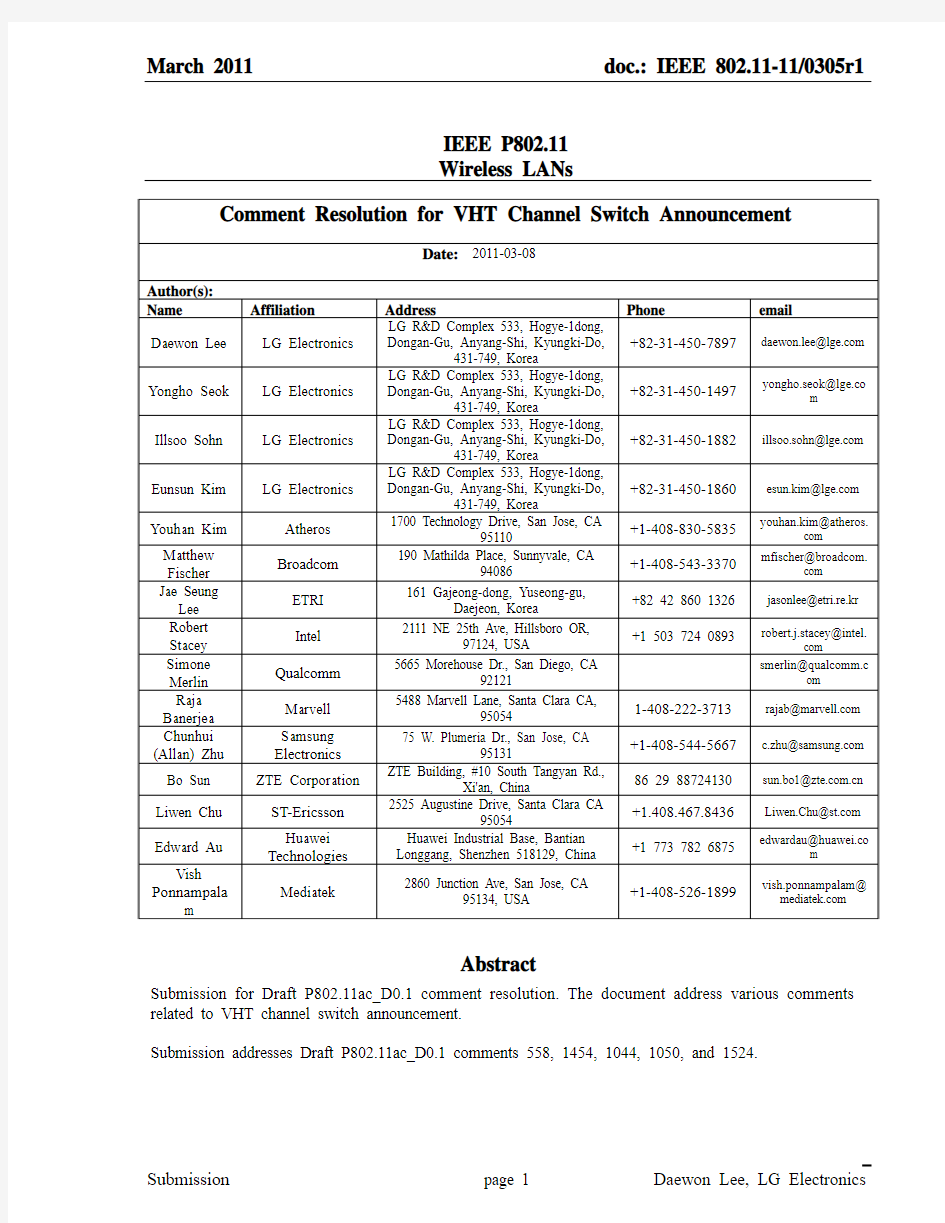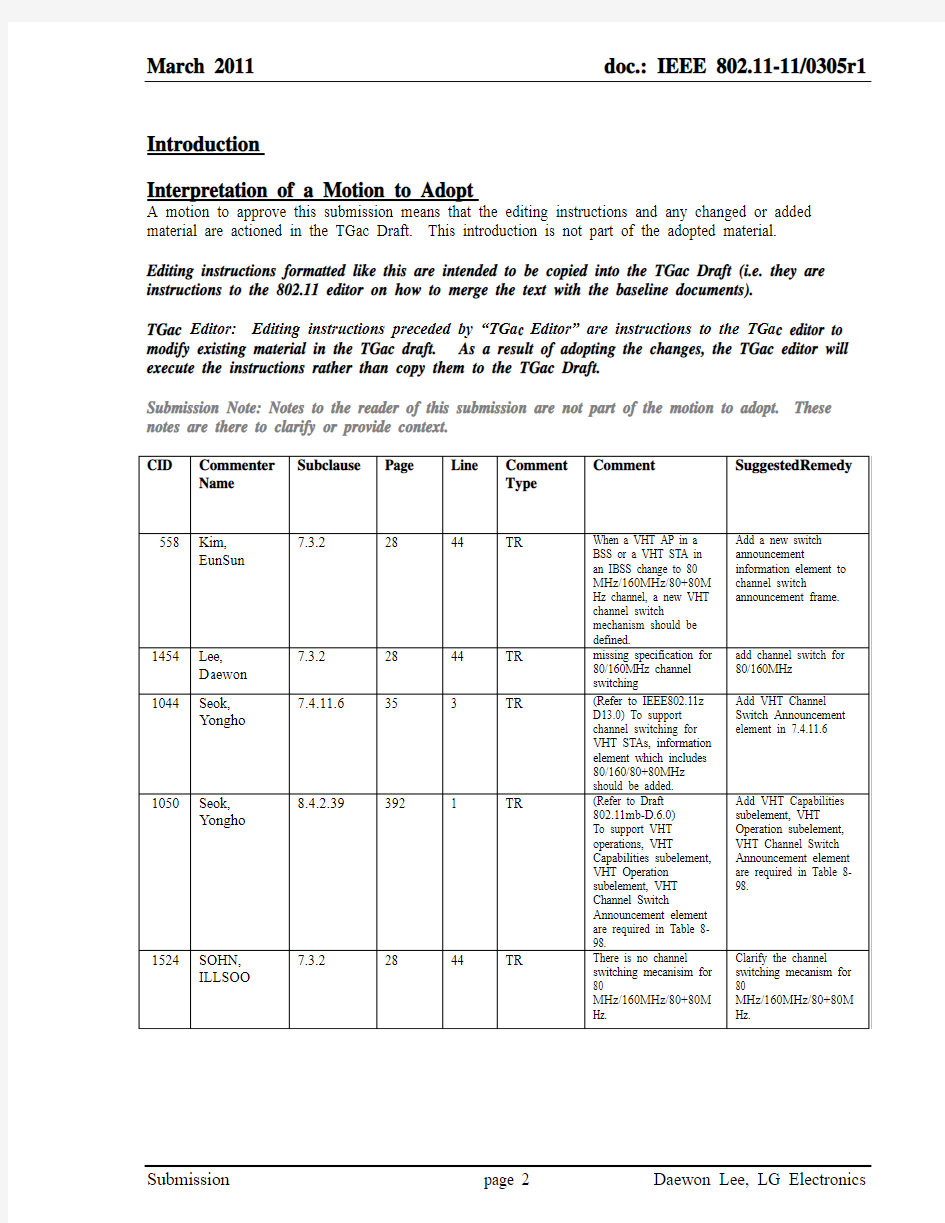

IEEE P802.11 Wireless LANs
Introduction
Interpretation of a Motion to Adopt
A motion to approve this submission means that the editing instructions and any changed or added material are actioned in the TGac Draft. This introduction is not part of the adopted material.
Editing instructions formatted like this are intended to be copied into the TGac Draft (i.e. they are instructions to the 802.11 editor on how to merge the text with the baseline documents).
TGac Editor: Editing instructions preceded by “TGa c Editor” are instructions to the TGa c editor to modify existing material in the TGac draft. As a result of adopting the changes, the TGac editor will execute the instructions rather than copy them to the TGac Draft.
Submission Note: Notes to the reader of this submission are not part of the motion to adopt. These notes are there to clarify or provide context.
Discussion:
The Channel Switch Announcement element is used by an AP in a BSS or a STA in an IBSS to advertise when it is changing to a new 20MHz primary channel. The Secondary Channel Offset element is used by an AP in a BSS or a STA in an IBSS together with the Channel Switch Announcement element when changing to a new 40 MHz secondary channel. To keep the legacy switching mechanisms backward compatible for VHT there should be mechanisms which support channel switching of 80MHz, 160MHz, and 80+80MHz BSS.
Essentially three potential candidates to extend the channel switch mechanism, one method is to extend the channel switch announcement frame, the second is to extend the extended channel switch announcement, and lastly to utilize some of the channel switch mechanism defined as part of the channel power management element for 11af.
The Extended Channel Switch Announcement Element mechanics works such that an IDO STA informs HT STAs within its BSS that it is performing channel pair relocation by including an Extended Channel Switch Announcement element in Beacon, Probe Response, and Extended Channel Switch Announcement frame transmissions until the intended channel switch time. The New Channel Number field of the Extended Channel Switch Announcement element represents the new channel (when the BSS after relocation/width change will be a 20 MHz BSS) or the primary channel of the new pair of channels (when the BSS after relocation/width change will be a 20/40 MHz BSS). When changing to a new pair of channels, the New Operating Class field specifies the position of the secondary channel relative to the new primary channel, i.e., either above or below.
The problem is that the Extended Channel Switch Announcement Element cannot be used by an AP in a BSS or a STA when changing to a new 80 MHz/160MHz/80+80MHz channel. The inherent problem is that VHT Operating Classes for 80MHz and 160MHz does not specifies the position of the primary and secondary channels by use of offsets, rather it specifies the channel bandwidth and the center carrier frequency in order to support 80, 160, and well as 80+80MHz BSS setups.
The Channel Power Management element used in 11af provides various TV White Space specific functionalities. The functionalities included in the CPM element are signaling of changes of channel availability, signaling of Maximum Transmit Power switching from the regulatory database, and signaling of Channel (and Power) switching. Even though the CPM element maybe able to indicate channel switching of 80, or 160MHz channels with some modification, the support of such element with all the functionalities therein in the 5GHz is rather not clear and may cause additional implementation needed for VHT 5GHz only support devices.
To keep the channel switch mechanism simple and considering the VHT is only supported in the 5GHz, we propose to extend the channel switch announcement frame by include one more additional information element. The inclusion of such information element is fully backward compatible to any legacy STAs. The included information element could look essentially the same as the BSS channel indication in the operation capability field, which is a combination of channel width, center frequency of first 80MHz segment, and center frequency of second 80MHz segment.
Proposed Resolution:
Agree in principle to finalize the TBD fields as described in Draft P802.11ac_D0.1 comments 558, 1454, 1044, 1050, and 1524. Also agree to following editing instructions to complete the section.
Editing instructions:
7.3.2 Information elements
TGac editor: Insert the following row in table 8-50, and renumber the reserved values accordingly:
Table 7-16—Element IDs
TGac editor: Insert the follow section after the 7.3.2.20a Secondary Channel Offset element section.
7.3.2.20b Wide Bandwidth Channel Switch element
Figure 7-57b—Wide Bandwidth Channel Switch element format
The Wide Bandwidth Channel Switch element is included in Channel Switch Announcement frames, as described in 7.4.1.5 (Channel Switch Announcement frame format).
The definition of subfields New STA Channel Width, New Channel Center Frequency Segment 1 and 2 are identical to definitions for STA Channel Width, Channel Center Frequency Segment 1 and 2 in the VHT Operation Information element field as described in Table 7-19 VHT Operational Information element fields of section 7.3.2.62 VHT Operation element respectively.
TGac editor: Change section 7.4.1.5 Channel Switch Announcement frame format as instructed below:
7.4.1.5 Channel Switch Announcement frame format
TGac editor: Replace Figure7-100Channel Switch Announcement frame Action field format with the following figure:
Octets:
Figure 7-100—Channel Switch Announcement frame format
TGac editor: Change last paragraph of section 7.4.1.5 as follows:
The Secondary Channel Offset element is defined in 7.3.2.20a (Secondary Channel Offset element). This element is present when switching to a 40 MHz or wider channel. It may be present when switching to a 20 MHz channel (in which case the secondary channel offset is set to SCN).
TGac editor: Insert the following paragraph after the last paragraph in section 7.4.1.5:
The Wide Bandwidth Channel Switch element is defined in section 7.3.2.20b (Wide Bandwidth Channel Switch
element). This information element is present when switching to channel width wider than 40MHz.